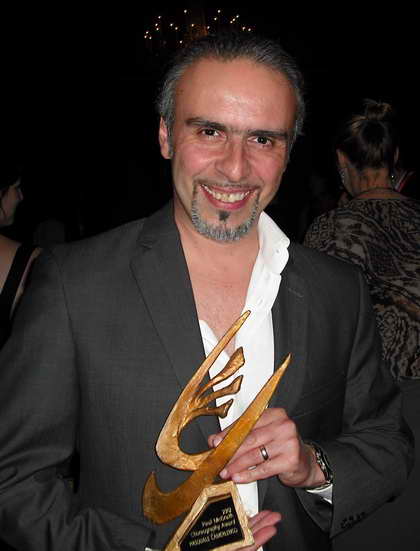|

(19 June 2012) Pasquale Camerlengo, the 2012 Professional
Skaters Association Paul McGrath Choreographer of the Year award
recipient, has become known as one of the hottest creative
commodities of the sport today and with perfectly good reason.
Last season, the former Italian ice dance
champion and Olympic contender created podium-worthy programs for
some major contenders including Daisuke Takahashi, the 2012 Japanese
World silver medallist, Nathalie Pechelat and Fabian Bourzat of
France, the 2012 World dance bronze medalists, Alissa Czisny, who
was second at the 2012 Nationals, Adam Rippon, the 2012 national
silver medallist and Madison Hubbell and Zachary Donahue, the dance
team who placed third at the 2012 Nationals.
Camerlengo, who is based at the Detroit Skating
Club in Bloomfield Hills, Michigan, has navigated his way to the
pinnacle of the domestic and world competitive rungs due to his keen
artistic understanding and excellent business acumen.
At the same time, he has a refreshing innocence
that was glaringly apparent during his acceptance speech for the
prestigious choreography honor at the PSA awards ceremony in Boston
last month.
“I don’t know what to say,” he told the crowd
at the Boston Park Plaza Hotel. “Thank you so much to everyone for
believing in me.”
Believing in Camerlengo seems to be rather
easy, especially in noting his successful track record.
Back in 1993, Camerlengo (who was fifth at the
1992 Olympics with Stefania Calegari) began working as a coach and
choreographer. His first foray into the latter realm turned out to
be a premonition for his later success, as he had been asked by the
late Carlo Fassi, the iconic coach who worked with Peggy Fleming,
the 1968 Olympic champion, Dorothy Hamill, the 1976 Olympic gold
medalist and John Curry, the deceased 1976 British Olympic titlist,
to do his skater’s programs in Milan, Italy.
During the millennium, Camerlengo had moved to
Delaware and became married to Anjelika Krylova, the Russian
two-time World ice dance champion. The couple had two children,
Stella and Anthony, in 2005 and 2007, respectively.
In 2006, Camerlengo and his family relocated to
the motor city where he really began to thrive.
There, he churned out many exceptional
programs, including some for Isobel Delobel and Olivier Schoenfelder
of France, the 2008 World titlists and Marie France Dubrueil and
Patrice Lauzon, the 2006 and 2007 Canadian World silver medallists,
among others.
Along the way, Camerlengo also joined forces
with Audrey Weisiger, the Olympic and World coach from Fairfax,
Virginia, and became involved with her popular Grassroots to
Champions team, a group of top-rated professionals who travel around
the country training and cultivating skaters.
During his acceptance speech in Boston,
Camerlengo made a point to thank Weisiger. “I would like to
thank one special person, Audrey Weisiger, who brought me to this
country,” he said.
In his speech, Camerlengo also cited the
significance of choreography. “Choreography is such as
personal gift of how you see skating,” he remarked.
Camerlengo said a good competitive program is
all about adhering to certain principles and explained how there are
no charts in choreography. Rather, it is “a chord, an emotion or
something that touches people.”
Camerlengo, who spoke about choreography to a
standing-room only crowd at the PSA Conference in Boston last month,
said choreographers ought to be clear on what they want to say or do
for the skater (or skaters) in between elements when creating a
program. They also should be clear about all of the rules.
“Programs now are very demanding, skaters have
to perform from beginning to end,” he said. “They need stamina and
quality of technique so they shouldn’t be too affected by
choreography.”
Camerlengo said music is the most important and
difficult aspect of putting together a program and explained how
once the proper music is chosen, “half the work is done.”
“With music, you have a vision,” said
Camerlengo. “The first thing is to really know the skater, what they
feel and what they would like to do.”
He used the film score from “Titanic” to
illustrate the music-decision process. A program with this music, he
said, would have to revolve around the story of the tragic sinking
of the ship and the loss of more than a thousand people, which is a
sad and delicate theme. At the same time, it would be best for a
pair or dance team since the film involves a love story.
“It is important to think of how you want to
present the concept of music,” he said. “Think about the skater’s
personality and their technical skills.”
Music editing is another paramount aspect of
effective choreography. Camerlengo recommended that coaches and
choreographers be directly involved with editors who understand the
technical elements since they need to be placed in synch with the
rhythms and nuances of the music.
“I have a guy who can put music together in a
way that matches the elements of the skaters,” he said. “It is a
huge help that he understands the elements.”
Once a program is created, skaters should be
able to execute the technical elements in exact accordance with the
music. “There is nothing worse than seeing things not done on
the music and nothing more beautiful than hitting the beats on the
music,” he said. “When a skater his a jump on the music it’s
like ‘wow’ and the marks are usually good even if the jump isn’t
perfect.”
Power also plays a paramount role in
choreography since acceleration of transitions translates into good
overall ice coverage, which is key.
“The transitions should be as intricate as
possible,” he said. “Skaters need to transfer all of their turns,
steps and edges into power and speed so their programs have a global
feel.”
Indeed, Camerlengo’s global mindset seems to be
the basis for his artistic success and could perhaps represent a
beginning in terms of where he might be
headed.
|

